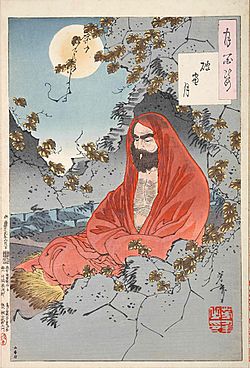Bodhidharma facts for kids
Quick facts for kids Bodhidharma
|
|||||||||||||||||||||||||||||||||||||||||||||||||||||||||||||
|---|---|---|---|---|---|---|---|---|---|---|---|---|---|---|---|---|---|---|---|---|---|---|---|---|---|---|---|---|---|---|---|---|---|---|---|---|---|---|---|---|---|---|---|---|---|---|---|---|---|---|---|---|---|---|---|---|---|---|---|---|---|

Bodhidharma, Ukiyo-e woodblock print by Tsukioka Yoshitoshi, 1887.
|
|||||||||||||||||||||||||||||||||||||||||||||||||||||||||||||
| Religion | Buddhism | ||||||||||||||||||||||||||||||||||||||||||||||||||||||||||||
| School | Chan | ||||||||||||||||||||||||||||||||||||||||||||||||||||||||||||
| Senior posting | |||||||||||||||||||||||||||||||||||||||||||||||||||||||||||||
| Title | Chanshi 1st Chan Patriarch |
||||||||||||||||||||||||||||||||||||||||||||||||||||||||||||
| Successor | Huike | ||||||||||||||||||||||||||||||||||||||||||||||||||||||||||||
| Religious career | |||||||||||||||||||||||||||||||||||||||||||||||||||||||||||||
| Students | Huike | ||||||||||||||||||||||||||||||||||||||||||||||||||||||||||||
Bodhidharma was a Buddhist monk who lived during the 5th or 6th century. He is traditionally credited as the transmitter of Chan Buddhism to China, and regarded as its first Chinese patriarch. According to Chinese legend, he also began the physical training of the monks of Shaolin Monastery that led to the creation of Shaolin kungfu. In Japan, he is known as Daruma.
According to the principal Chinese sources, Bodhidharma came from the Western Regions, which refers to Central Asia but may also include the Indian subcontinent, and was either a "Persian Central Asian" or a "South Indian [...] the third son of a great Indian king.
Throughout Buddhist art, Bodhidharma is depicted as an ill-tempered, profusely-bearded, wide-eyed non-Chinese person. He is referred as "The Blue-Eyed Barbarian" in Chan texts.
Aside from the Chinese accounts, several popular traditions exist regarding Bodhidharma's origins.
The accounts also differ on the date of his arrival, with one early account claiming that he arrived during the Liu Song dynasty (420–479) and later accounts dating his arrival to the Liang dynasty (502–557). Bodhidharma was primarily active in the territory of the Northern Wei (386-634). Modern scholarship dates him to about the early 5th century.
Bodhidharma's teachings and practice centered on meditation and the Laṅkāvatāra Sūtra. The Anthology of the Patriarchal Hall (952) identifies Bodhidharma as the 28th Patriarch of Buddhism in an uninterrupted line that extends all the way back to the Gautama Buddha himself.
Images for kids
-
the same cave temple]] (No. 9) as ethnic Sogdians, an Eastern Iranian people who inhabited Turfan as an ethnic minority community during the phases of Tang Chinese (7th–8th century) and Uyghur rule (9th–13th century).
-
Ming dynasty (1368 - 1683) sandstone statue of a seated Bodhidharma (Chinese: 達磨; Pinyin: Dámó). 1484.
-
This Japanese scroll calligraphy of Bodhidharma reads, "Zen points directly to the human heart, see into your nature and become Buddha." It was created by Hakuin Ekaku (1686 to 1769)
-
Bodhidharma, stone carving in Shaolin Temple.
-
Dazu Huike offering his arm to Bodhidharma. Ink painting by Sesshū Tōyō, 1496, Muromachi period, Japan.
-
Qing dynasty (1644 - 1911) statuette of Bodhidharma. 19th century.
-
Paint of Bodhidharma at Himeji Castle. Edo period, Japan.
-
A Dehua ware porcelain statuette of Bodhidharma from the late Ming dynasty, 17th century
-
Bodhidharma (Chinese: 達磨; Hiragana: だるま; Romaji: Daruma), painted by Miyamoto Musashi, swordsman artist and philosopher close to Takuan Soho monk of the Rinzai sect (linked to the samurai caste) founded by the 28th Patriarch.
See also
 In Spanish: Bodhidharma para niños
In Spanish: Bodhidharma para niños











